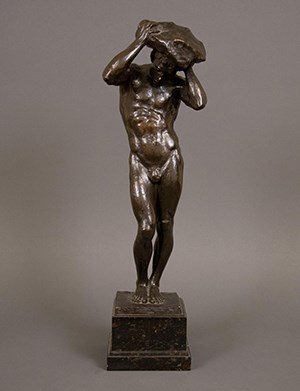
Two large tapestries flanking the doorway are from a series depicting episodes of the Trojan War (the others from the set hang in the South Foyer). The east and west walls feature a pair of late sixteenth- or early seventeenth-century Italian armorial tapestries bearing the Medici family coat of arms. The room is furnished with a combination of antique Renaissance furnishings and Louis XV style seating. A guest visiting the mansion in 1923 remembered the chairs arranged in conversational groups, and flowers everywhere. Following dinner, men would remain in the dining room for cigars, while the ladies would retire to the Living Room for coffee and liquors. The men would later join them for games of cards, charades, and music. Furnishings of Note
"The History of Troy" TapestriesFour tapestries made in the seventeenth century in the workshop of Martin Reynbouts illustrate the history of Troy, one of the most enduring stories from Greek mythology. 
Steinway & Sons Concert Grand PianoThe piano is decorated with oval portrait busts depicting classical composers and ribbon borders containing lyric verse by Milton and Shakespeare from three sources—AND EVER AGAINST EATING CARES, LAP ME IN SOFT LYDIAN AIRES, MARRIED TO IMMORTAL VERSE; HERE WELL WE STAND AND LET THE SOUNDS OF MUSIC, CREEP IN OUR EARS; AS MAY WITH SWEETNESS, THROUGH MINE EAR, DISSOLVE ME INTO ECSTASIES.
CaryatidInfluenced by the work of French sculptor Auguste Rodin, this bronze cast by Gertrude Vanderbilt Whitney (1875-1942) was a study for one of three standing male nudes supporting the basin of a large marble fountain now at McGill University in Montreal, but originally designed for the Arlington Hotel in Washington, DC. In 1913, it was awarded Honorable Mention at the Paris Salon, and received the National Arts Club Prize of the Association of Women Painters and Sculptors in 1914. Gertrude Vanderbilt Whitney was the daughter of Corneilus Vanderbilt II and Alice Claypoole Gwyne and married Harry Payne Whitney. Sculptor, art patron and collector, she founded the Whitney Museum of American Art in 1931.Restoration & Conservation
Reproduction of the Living Room CurtainsIt took three years and many hands to reproduce the Living Room curtains. Highly skilled craftsmen wove the velvet by hand on 18th-century looms, the very same looms that may have manufactured the original velvet in 1895. |
Last updated: January 27, 2022
